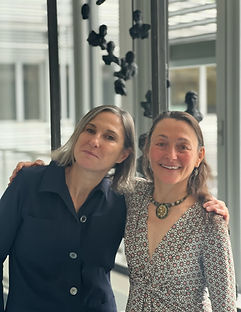SCULPTURES
Step into the world of three-dimensional storytelling, where sculpture becomes a powerful medium to convey emotion and narrative. This section celebrates the transformative impact of sculpture. Each piece invites you to embark on a sensory journey, exploring the intricate relationship between form and feeling, and revealing the unique ability of art to transcend time and space.
Sandrine Donnio Renaud
Sandrine Donnio Renaud’s childhood was influenced by the history and the work of the sculptor Francis Renaud. He was the cousin of her grandfather and passed away in 1973 shortly after her birth. By observing his monumental sculptures in Brittany and Paris she became familiar with the strength of volumes and their symbolic meaning. After a first career in business, she started working with clay for the first time in 2011. As soon as she is in contact with clay, she feels intimately connected to this family history and sculpture becomes her means of expression. From 2013 onwards, her interest in volumes led her to learn about plaster work, which enabled her to envisage making large-format sculptures. Here, the bodies are deformed and take their freedom in a soaring or heavy movement, while the whiteness of the material captures or reflects the light depending on the roughness of the surface. She has exhibited her work since 2017, in particular with a solo exhibition at the Pavillon Davioud in the Jardin du Luxembourg at the invitation of the French Senate in July 2019. In December 2022, her sculpture "Transgenerational Memory", inspired by a lecture given by Isabelle Mansuy on the legacy of trauma, was inaugurated at the Brain Research Institute, in Zurich, Switzerland.

Transgenerational Memory (Steel Piano strings Plaster 2021)

Questioning (Wire Tow Plaster 2021) & Transgenerational Memory (Steel Piano strings Plaster 2021)


Michael Skinner and Isabelle Mansuy with the artist, Sandrine Donnio Renaud, in Paris (2022)




Vernissage of “Transgenerational Memory” in the presence of the artist at the Brain Research Institute (University of Zurich, Switzerland) on December 13, 2022.
Flo[rence] David Razoux
Flo[rence] David Razoux is a researcher, creator and educator. Their scientific work follows an interest in better understanding the neurobiological basis of emotions, and has investigated neurochemical, electrophysiological and behavioral changes in various animal models of neuropsychiatric conditions such as schizophrenia, anxiety, and affective disorders. In their artistic practice, Razoux explores the notion of identity, perception, and the dichotomy between the body and the mind. In a constant quest for innovation, beauty and meaning, Razoux uses emerging technology and experiments with scientific concepts to create multimedia performances, interactive installations and immersive experiences that invite the public to reconsider our current understanding of the world and question the elusiveness of the established systems. Razoux started their career as a classical musician and holds a music degree in instrumental harp and music theory from the French Conservatoire. After pursuing scientific studies at the University of Nice Sophia-Antipolis (FR), they discovered a strong interest for neuropsychopharmacology. Razoux eventually graduated with a PhD in biomedical engineering and neurosciences from the ETH Zurich (CH) and deepened their expertise in neuroimaging and brain physiology during a postdoctoral training at the UCSD (USA) and MDC Berlin (DE). In parallel to their scientific career, Razoux started to explore an interdisciplinary creative landscape and has gradually become an active member of the Art & Science community. Their work has been presented internationally, from London to Berlin, Paris to New York and Los Angelos. In 2019, their work "Waddington", a sculpture that represents the influence of the environment on the level of expression of the genes, was shown at the Epigenetic Inheritance Symposium at ETH Zurich, Switzerland. Razoux is the founder of Zweigeist Berlin, a platform that promotes open science and encourages the dialogue between scientists and the public on diverse neuroscientific topics.

Original diagram of Waddington (1957)

Waddington scultpure (solo exhibition 2019). The integration of crystals into the resin cast refers to the influence of the environmental conditions on the development of a system or structure.

Me (CH3) sculpture (solo exhibition 2019).
Reference to the individuality (fingerprints), identify through actions taken, perception/understanding of epigenetic inheritance by the broad audience.